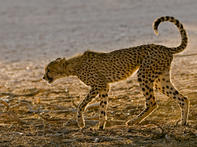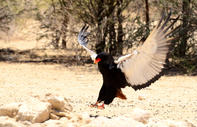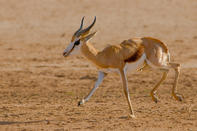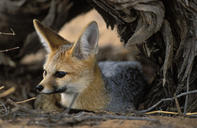Mystical Kalahari Magic
The Kgalagadi is classed as arid savanna due to its ample tree, shrub and grass cover. Although the Kgalagadi Transfrontier Park is better known as an excellent place to see big predators, the seasonal rivers are in fact the very best sites to see raptors, without even trying.
The landscape - endless red sand dunes punctuated with blond grass and the odd thorn tree - is dominated by two dry riverbeds, where most of the game and large carnivores are concentrated. The large acacia trees that line the Nossob River are in fact a linear oasis that provides suitable habitat for the resident bateleur, martial and verreaux's eagles, and black-chested and brown snake-eagles. Vast herds of wild game still roam here, mysteriously following the rains; the last few remaining San hunter-gatherers still eke out a precarious life secret from its secret bounty; and the relentless sun beats down on the ground so flat that you can see the curve of the earth.
Animals of the Kgalagadi
The Kgalagadi is a haunting place of dune seas, big predators, dry savanna and riverbeds. Icon of the park is the oryx (or gemsbok), a regal antelope that can exist in the harshest, hottest, driest places, and a host of rare desert species such as the springbok, the elusive aardvark, and the tiny Cape fox. Joining these are leopards, cheetahs, eland, blue wildebeest, meerkats, and mongoose.
At certain times of year you can also find the migrant steppe, lesser spotted, booted and Wahlberg's eagles. Then there are vultures, goshawks, buzzards, harriers kestrels, falcons, owls and many more.



